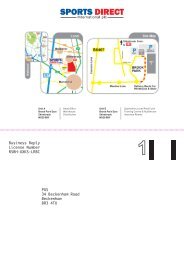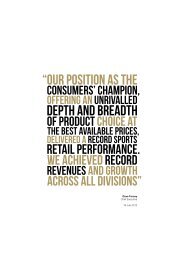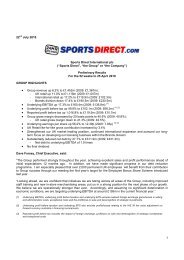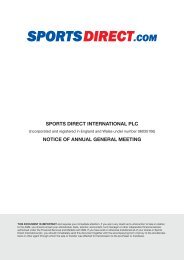Sports Direct Is The UK's Leading Sports Retailer - Sports Direct ...
Sports Direct Is The UK's Leading Sports Retailer - Sports Direct ...
Sports Direct Is The UK's Leading Sports Retailer - Sports Direct ...
Create successful ePaper yourself
Turn your PDF publications into a flip-book with our unique Google optimized e-Paper software.
1. aCCountinG poliCies<br />
<strong>The</strong> consolidated financial statements of <strong>Sports</strong> <strong>Direct</strong> International Plc (the<br />
“Company”) and its subsidiaries (together the “Group”) have been prepared in<br />
accordance with International Financial Reporting Standards as adopted by the<br />
European Union (“IFRS”).<br />
No new IFRSs, International Financial Reporting Interpretations Committee<br />
(IFRIC) interpretations and amendments have been adopted in the financial<br />
statements.<br />
Basis of preparation<br />
<strong>The</strong> consolidated financial statements have been prepared in accordance<br />
with IFRS as adopted for use in the European Union (including International<br />
Accounting Standards (“IAS”) and International Financial Reporting<br />
Interpretations Committee (“IFRIC”) interpretations) and with those parts of the<br />
Companies Act 2006 applicable to companies reporting under IFRS as adopted<br />
for use in the European Union. <strong>The</strong> consolidated financial statements have<br />
been prepared under the historical cost convention, as modified to include fair<br />
valuation of financial assets and derivative financial instruments.<br />
Consolidation<br />
<strong>The</strong> consolidated financial statements consolidate the revenues, costs, assets,<br />
liabilities and cash flows of the Company and its subsidiaries, being those<br />
entities in relation to which the Company has the power to govern the financial<br />
and operating policies, generally achieved by a share of more than 50% of the<br />
voting rights.<br />
On acquisition, the assets and liabilities and contingent liabilities of a subsidiary<br />
are measured at their fair values at the date of acquisition. Any excess of the<br />
cost of acquisition over the fair values of the identifiable net assets acquired is<br />
recognised as goodwill. Any deficiency of the cost of acquisition below the fair<br />
values of the identifiable net assets acquired is credited to the consolidated<br />
income statement in the period of acquisition. <strong>The</strong> interest of minority<br />
shareholders is stated at the minority’s proportion of the fair values of the<br />
assets and liabilities and contingent liabilities recognised.<br />
<strong>The</strong> results of subsidiaries acquired or disposed of during the year are included<br />
in the consolidated income statement from the effective date of acquisition or up<br />
to the effective date of disposal, as appropriate.<br />
Inter-company transactions, balances and unrealised gains and losses on<br />
transactions between Group companies are eliminated.<br />
associates and joint ventures<br />
Associates are entities over which the Group has significant influence but not<br />
control, generally accompanied by a share of between 20% and 50% of the<br />
voting rights.<br />
A joint venture is an entity in which the Group holds an interest on a long<br />
term basis and which is jointly controlled by the Group and one or more other<br />
ventures under a contractual agreement.<br />
<strong>The</strong> Group’s share of the results of associates and joint ventures is included<br />
in the Group’s consolidated income statement using the equity method of<br />
accounting. Investments in associates and joint ventures are carried in the<br />
Group’s consolidated balance sheet at cost plus post acquisition changes in the<br />
Group’s share of the net assets of the associates, less any impairment in value.<br />
<strong>The</strong> carrying values of investments in associates and joint ventures include<br />
acquired goodwill.<br />
If the Group’s share of losses in an associate or joint venture equals or exceeds<br />
its investment in the associate or joint venture, the Group does not recognise<br />
further losses, unless it has incurred obligations to do so or made payments on<br />
behalf of the associate or joint venture.<br />
Unrealised gains arising from transactions with associates and joint ventures<br />
are eliminated to the extent of the Group’s interest in the entity.<br />
investments<br />
For available-for-sale investments (except for contracts for difference), gains<br />
and losses arising from changes in fair value are recognised directly in equity<br />
through the statement of recognised income and expense, until the security is<br />
disposed or derecognised at which time the cumulative gain or loss previously<br />
recognised in equity is included in the consolidated income statement for<br />
the period. If an available-for-sale investment is determined to be impaired,<br />
the cumulative loss previously recognised in equity is included in the income<br />
statement for the period.<br />
Contracts for difference are a type of financial instrument and therefore<br />
gains and losses arising from changes in fair value of these investments are<br />
recognised directly in the income statement.<br />
notes to the finanCial statements for the 52 weeks ended 26 april 2009<br />
Goodwill<br />
Goodwill arising on consolidation is recognised as an asset and reviewed for<br />
impairment at least annually or when a change in circumstances or situation<br />
indicates that the goodwill has suffered an impairment loss. Any impairment<br />
is recognised immediately in the income statement. Gains and losses on the<br />
disposal of a business include the amount of goodwill relating to that business.<br />
When the minority interests of an existing subsidiary are acquired the carrying<br />
value of the minority interests in the balance sheet is eliminated. <strong>The</strong> excess of<br />
consideration over the carrying value of the minority interests is recognised in<br />
the balance sheet as goodwill and is not amortised.<br />
other intangible assets<br />
Brands, trade marks and licences that are internally generated are not recorded<br />
on the balance sheet. Acquired brands, trade marks and licences are initially<br />
carried on the balance sheet at cost. <strong>The</strong> fair value of brands, trade marks and<br />
licences that are acquired by virtue of a business combination is determined at<br />
the date of acquisition and is subsequently assessed as being the deemed cost<br />
to the Group.<br />
No amortisation is charged on brands, trade marks or perpetual/renewable<br />
licences with an indefinite life as the Group believes that the value of these<br />
brands and trade marks can be maintained indefinitely. <strong>The</strong> Group carries out<br />
an impairment review on the intangible assets, at least annually, or when a<br />
change in circumstances or situation indicates that those brands have suffered<br />
an impairment loss. Impairment is measured by comparing the carrying<br />
amount of the intangible asset as part of the cash generating unit (CGU) with the<br />
recoverable amount of the CGU, that is, the higher of its fair value less costs to<br />
sell and its value in use. Value in use is calculated by discounting the expected<br />
future cash flows, using a discount rate based on an estimate of the rate that<br />
the market would expect on an investment of comparable risk.<br />
Amortisation is provided on brands, trade marks and licences with a definite<br />
life over their useful economic lives of 10 to 15 years and is accounted for within<br />
the selling, distribution and administrative expenses category within the income<br />
statement.<br />
property, plant and equipment<br />
Property, plant and equipment are stated at historical cost less depreciation<br />
less any recognised impairment losses. Cost includes expenditure that<br />
is directly attributable to the acquisition or construction of these items.<br />
Subsequent costs are included in the asset’s carrying amount only when it is<br />
probable that future economic benefits associated with the item will flow to the<br />
Group and the costs can be measured reliably. All other costs, including repairs<br />
and maintenance costs, are charged to the income statement in the period in<br />
which they are incurred.<br />
Depreciation is provided on all property, plant and equipment other than<br />
freehold land and is calculated on a reducing balance basis or straightline<br />
basis, whichever is deemed by the directors to be more appropriate, to<br />
allocate cost less assessed residual value, other than assets in the course of<br />
construction, over the estimated useful lives, as follows:<br />
Freehold buildings - 2% per annum<br />
Leasehold property - over the term of the lease<br />
Plant and equipment - between 5% and 33% per annum<br />
<strong>The</strong> assets’ useful lives and residual values are reviewed and, if appropriate,<br />
adjusted at each balance sheet date.<br />
<strong>The</strong> gain or loss arising on disposal or scrapping of an asset is determined as<br />
the difference between the sales proceeds, net of selling costs, and the carrying<br />
amount of the asset and is recognised in the income statement.<br />
impairment of assets other than goodwill and intangible assets with an<br />
indefinite life<br />
At each balance sheet date, the directors review the carrying amounts of the<br />
Group’s tangible and intangible assets, other than goodwill and intangible<br />
assets with an indefinite life, to determine whether there is any indication that<br />
those assets have suffered an impairment loss. If any such indication exists, the<br />
recoverable amount of the asset is estimated in order to determine the extent<br />
of the impairment loss, if any. Where the asset does not generate cash flows<br />
that are independent from other assets, the Group estimates the recoverable<br />
amount of the cashgenerating unit to which the asset belongs.<br />
Recoverable amount is the higher of fair value less costs to sell and value in<br />
use. In assessing value in use, the estimated future cash flows are discounted<br />
to their present value using a pre-tax discount rate that reflects current market<br />
assessments of the time value of money and the risks specific to the asset for<br />
which the estimates of future cash flows have not been adjusted.<br />
<strong>Sports</strong> <strong>Direct</strong> International PLC Annual Report 2009 37



![Our ref: [ ] - Sports Direct International](https://img.yumpu.com/19248141/1/184x260/our-ref-sports-direct-international.jpg?quality=85)






![Our ref: [ ] - Sports Direct International](https://img.yumpu.com/18440214/1/184x260/our-ref-sports-direct-international.jpg?quality=85)
